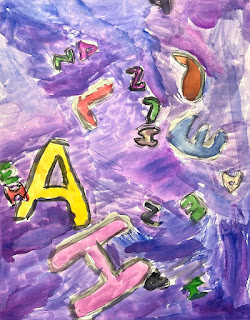Hidden Word PaintingsLearning Targets
I can...
- Create an original Hidden Word Paintings using drawing techniques learned in class
- Use line types (horizontal, vertical, diagonal), shape variation (geometric, organic, free form), and space (positive, negative) inspired by American Painter (1943-Present) Kay Rosen
- Use typography (font, contrast, grids, spacing) and design principles (proportion, repetition, balance) based on Contemporary Art
- Define Font (a graphical representation of text that can have different sizes, colors, or designs)
Lesson One
Day One, Art Start
1. Turn (2018) Kay Rosen
2. Read Type: A Visual History Of Typefaces And Graphic Styles (1628-1900) by Jan Tholenaar
3. Discussion Questions "Did you leave adequate spacing in the artwork? Is the color contrast optimized for legibility? Are the sizes effective? Does the typography communicate visually? Are the formats consistent? Is the text effective on all devices? What emotions and moods do these fonts express? How do these Eries of words present a message? What is the difference between kerning and tracking? What is important about kerning and tracking when designing artwork? Have you tried the method of foil printing? What is letter? How do you know? How does it look the same as the one we used? What are the differences?"
Lesson Activities
1. Choose 12" X 15" Painting Paper
2. Use protractors, rulers, and letter stencils to fill in the positive space (letters) of the word paintings
3. Use size differentiation (small, medium, large) to add a focal point in the positive space (letters) of the Hidden Word Paintings
Day Two, Art Start
1. Retrieve Hidden Word Paintings for Assigned Tables
2. This Means War (2015) Kay Rosen
3. Discussion Questions "What happens when you overlap things in your own artwork? What similarities do you notice in these artworks? What differences do you notice in these artworks? How could you use a stencil to create letters in your own artwork? What are some ways you can make an object, person, or place look like a print? What is a font? What is a stroke? What is a foot in a letter? What is uppercase? What is lowercase? Does the typography communicate visually? What is going on in this artwork? What was your first reaction to this artwork? Why do you think you had this reaction? does your opinion about the artwork change the longer you look at it? What types of liens are being used in this artwork? What types of colors are being used in this artwork? Which area of the artwork is emphasized by the artist? Which area of the artwork is most important?"
Lesson Activities
1. Use protractors, rulers, and letter stencils to fill the negative space (background) of the word paintings
2. Use size differentiation (small, medium, large) to add a focal point in the negative space (background) of the word paintings
3. Use highlights (reflective light, light source, highlights) to fill in the positive space (foreground) of the Hidden Word Paintings
Day Three, Art Start
1. Retrieve Hidden Word Paintings for Assigned Tables
2. Set Up Studio Area (tempera paint, scissors, glue sticks, paintbrushes)
Lesson Activities
1. Use shadows (reflective shadow, cast shadow, shadow) to fill in the negative space (background) of the word paintings
2. Use neutral colors (black, grey, white, brown) to fill in the negative space (background) of the word paintings
3. Add relief pieces (styrofoam pieces, cardboard, poster board) to fill in the positive space (foreground) of the Hidden Word Paintings


































